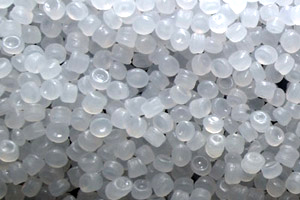Polypropylene(PP)

Polypropylene (PP) produced with Ziegler-Natta catalysts typically has a broad molecular weight distribution (MWD (. This results in a very high melt elasticity which causes problems with high-speed equipment.
The most common method of Polypropylene melt flow modification is this chemical degradation through the use of liquid additive
By adding of specific % of our Masterbatch to PP in an extruder. The problem can be overcome. Allowing for controlled degradation of the polymer (visbreaking). Controlled rheology polypropylene (CR-PP) extends and improves the characteristics of PP.
Carrier Resin : Polypropylene
Appearance : Granule (Pellet)
Half Life Time : 10h/1h/1min 120℃ / 142℃ / 190 ℃
Recommended Storage Temperature: 10 to 30℃
Storage Stability : 6 months
Applications
Increase of melt flow during processing
- In polymerization process
- In compounding process
- In fiber fabrication process like Spunbond & Meltblown
It is designed for direct addition on the production of PP synthetic fiber or nonwoven fabric. But please using drying machinery or high – speed mixer to dry the masterbatch before application.
Our Masterbatch narrow MWD and at the same time reduce average molecular weight. The decrease in melt viscosity, expressed by an increase in melt flow index (MFI), is controlled by the amount of right raw material addition. Application include PP film, extrusion coating, Fibers ( spunbond, meltblown ) and injection molding.
MFI change by our product:
As example: PP MFI 25 with adding of 2-3% of our products will be reached to MFI 70 – 90.
( The A.M. is a test done by our lab single compounding, Processing Temperature 190/ 210/220/220/210 (℃) ,Screw Speed of 70 RPM.)
Technical Data
Polypropylene fiber used in residential and commercial carpeting has grown significantly since being introduced in the MID-1970s. Durability and color fastness make p.p. fiber particularly suited for commercial markets such as offices, hotels and restaurants.
High molecular weight hindered amine light stabilizers (HALS) are widely accepted as the state -of-the -art technology to enhance p.p. fiber performance under demanding condition. In figure 1, results obtained after florida exposure.
Sample: P-P homopolymer, 130/37 dernier, white pigment.
Base stabilization: 0.2 % irganox B 501 W + 0.1 % calcium stearate.
Exposure: Florida 45° south .
Test criterion: hours to 50 % retained tensile strength.
Light stabilizer
Control:
1.5% Rangdaneh sirjan u.v. stabilizer with senergy effects kly ( kilolangleys) 140 kly.
HALS chemical name:
mixture of poly [[6-[(1,1,3,3,-tetramethyl , butyl) amino]-1,3,5-triazine-2,4diyl][[2,2,6,6- tetramethyl-4-piperidyl) imino] hexamethylene [[2,2,6,6,- tetramethyl-4- piperidyl) imino]] and dimethyl succinate polymer with 4-hydorxy-2,2,6,6-tetramethyl-1-piperidineethanol.
Composition:
Masterbatch of high molecular weight hindered amine light stabilizer (HALS) in polypropylene carrier.
Active content: <= 20 % HALS
Synergy:
A chemical phenomenon in which interaction of active components of a mixture is such that total effect is greater than the sum of the individual effect . Elements of synergy of HALS combinations.
• The solubility of HALS within the polymer matrix is increased.
• The solubility of the nitroxyl radical (the active stabilizing species) is enhanced.
• Stabilizer mobility is effectively balanced.
• Rate of nitroxyl radial formation is optimized.
• Compatibility with co-additives can be improved.
• Different HALS mechanisms are complementary.
Main Characteristics:
• Low volatility effective as anti-oxidant for long-term heat stability of polyolefins.
• Gas fading resistance in light coloured fiber.
• Improved colour yield in pigmented fiber.
• Increasing of the solubility of HALS whitin the polymer matrix.
• Balancing of stabilizer mobility.
• Improving of compatibility with co-additives.
Storage: To be stored cool and dry.
Technical Data:Ragdanehs products are specially dispersed pigment preparation of high grade organic, classic organic and inorganic pigments in polyolefin carrier, and they are used in the poypropylene and polyethylene coarse textile products, and because of special polypropylene carrier, all the requirements of bulk practice for fine-dinier and B.C.F. filament yarns are met:
• Good physical and mechanical properties.
• Favorable rheological properties in spinning process.
• No negative effect on the fiber values.
• Excellent filterability, heat stability, and textile fastness properties.